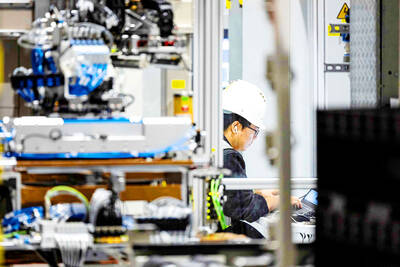Nanya Technology Corp (
The loss was NT$1.66 billion (US$51 million), or NT$0.35 per share, in the third quarter, compared with a profit of NT$5.17 billion, or earnings per share of NT$1.35, a year earlier, Taoyuan-based Nanya said today.
The result missed analyst estimates. Sales dropped 34 percent to NT$13.4 billion.
Lower prices for the main memory used in personal computers led to a loss at Nanya and smaller chip earnings at leading rival Samsung Electronics Co after PC makers didn't order as much as producers expected. Prices of benchmark dynamic random access memory (DRAM) chip tumbled 36 percent in the third quarter from the second, according to Dramexchange.com (集邦科技), Asia's biggest spot market for semiconductors.
"We didn't see any demand during the traditionally strong back-to-school season this third quarter," vice president Pai Pei-lin (白培霖) said at a briefing in Taoyuan.
DRAM prices are still "under pressure" this quarter and may recover in the middle of next year, Pai said.
Samsung, the world's largest memory chipmaker, said on Oct. 12 that third-quarter global PC shipments increased 10 percent from three months earlier, less than the 13 percent it estimated.
Nanya shares fell 3.9 percent to NT$21.25 at the close on the Taiwan Stock Exchange, before earnings were released. The TAIEX index dropped 2.6 percent.
The average estimate of nine analysts compiled by Bloomberg was for a profit of NT$130 million at Nanya. The company trails Hsinchu-based Powerchip Semiconductor Corp (
Nanya said it would maintain planned spending of NT$60 billion this year and trim the amount to NT$30 billion next year.
Its operating loss margin, or the percentage of sales left after taking away the cost of goods sold and administrative expenses, was 16 percent. A year earlier, the company had a profit margin of 20 percent.
Inotera Memories Inc (華亞科技), the memory-chip venture of Nanya and Qimonda AG, posted a 90 percent drop in third-quarter net income to NT$443 million. Profit missed the NT$548 million average of 12 estimates compiled by Bloomberg.
Inotera did not expect DRAM prices to recover until the first quarter of next year, president Charles Kau (
Inotera would cut its planned spending by 12 percent to NT$45 billion this year and reduce it again to NT$30 billion next year, Kau said.
The company plans to raise between NT$9 billion and NT$10 billion in order to upgrade its factories by selling 300 million new shares in the fourth quarter, he said.

CHIP RACE: Three years of overbroad export controls drove foreign competitors to pursue their own AI chips, and ‘cost US taxpayers billions of dollars,’ Nvidia said China has figured out the US strategy for allowing it to buy Nvidia Corp’s H200s and is rejecting the artificial intelligence (AI) chip in favor of domestically developed semiconductors, White House AI adviser David Sacks said, citing news reports. US President Donald Trump on Monday said that he would allow shipments of Nvidia’s H200 chips to China, part of an administration effort backed by Sacks to challenge Chinese tech champions such as Huawei Technologies Co (華為) by bringing US competition to their home market. On Friday, Sacks signaled that he was uncertain about whether that approach would work. “They’re rejecting our chips,” Sacks

It is challenging to build infrastructure in much of Europe. Constrained budgets and polarized politics tend to undermine long-term projects, forcing officials to react to emergencies rather than plan for the future. Not in Austria. Today, the country is to officially open its Koralmbahn tunnel, the 5.9 billion euro (US$6.9 billion) centerpiece of a groundbreaking new railway that will eventually run from Poland’s Baltic coast to the Adriatic Sea, transforming travel within Austria and positioning the Alpine nation at the forefront of logistics in Europe. “It is Austria’s biggest socio-economic experiment in over a century,” said Eric Kirschner, an economist at Graz-based Joanneum

BUBBLE? Only a handful of companies are seeing rapid revenue growth and higher valuations, and it is not enough to call the AI trend a transformation, an analyst said Artificial intelligence (AI) is entering a more challenging phase next year as companies move beyond experimentation and begin demanding clear financial returns from a technology that has delivered big gains to only a small group of early adopters, PricewaterhouseCoopers (PwC) Taiwan said yesterday. Most organizations have been able to justify AI investments through cost recovery or modest efficiency gains, but few have achieved meaningful revenue growth or long-term competitive advantage, the consultancy said in its 2026 AI Business Predictions report. This growing performance gap is forcing executives to reconsider how AI is deployed across their organizations, it said. “Many companies

France is developing domestic production of electric vehicle (EV) batteries with an eye on industrial independence, but Asian experts are proving key in launching operations. In the Verkor factory outside the northern city of Dunkirk, which was inaugurated on Thursday, foreign specialists, notably from South Korea and Malaysia, are training the local staff. Verkor is the third battery gigafactory to open in northern France in a region that has become known as “Battery Valley.” At the Automotive Energy Supply Corp (AESC) factory near the city of Douai, where production has been under way for several months, Chinese engineers and technicians supervise French recruits. “They